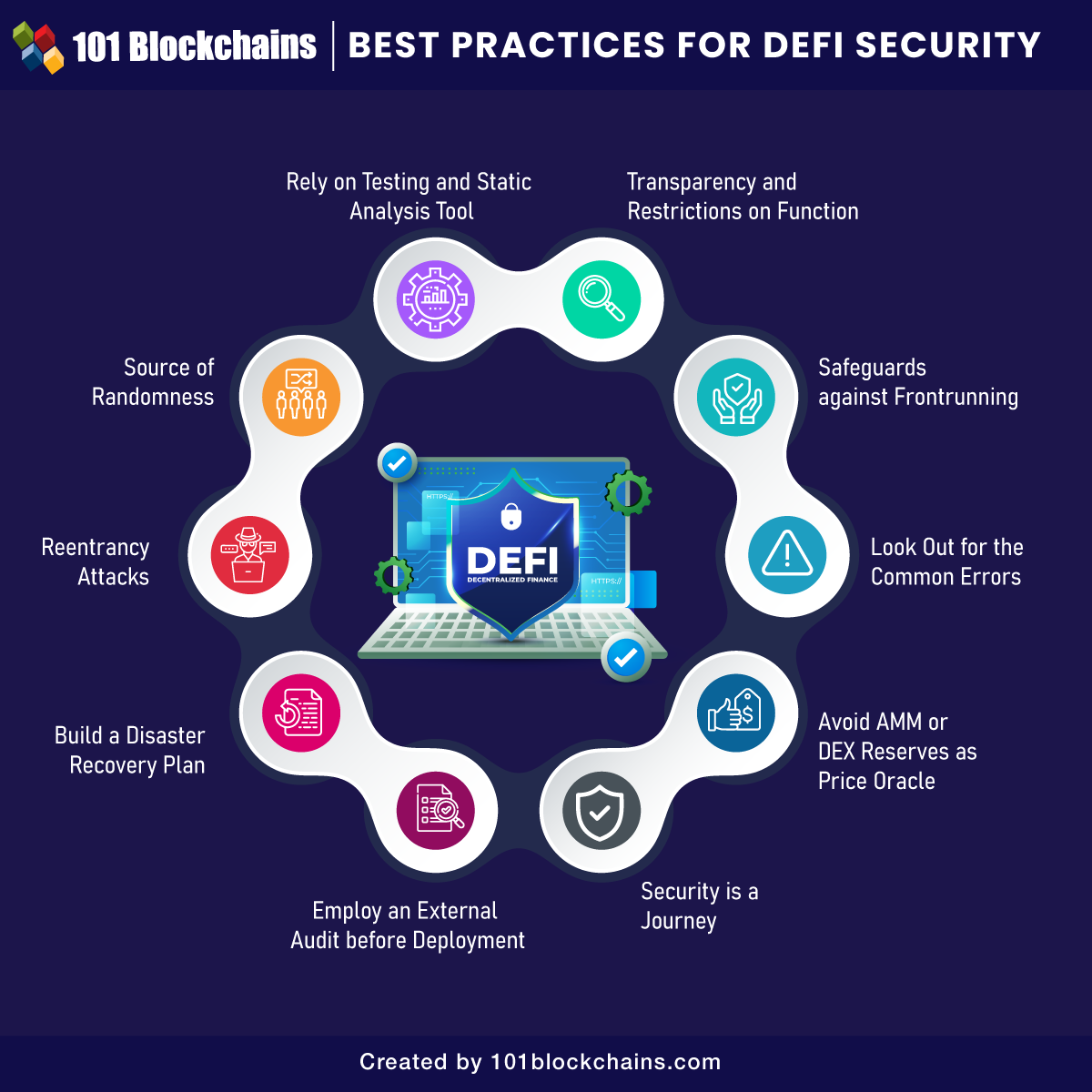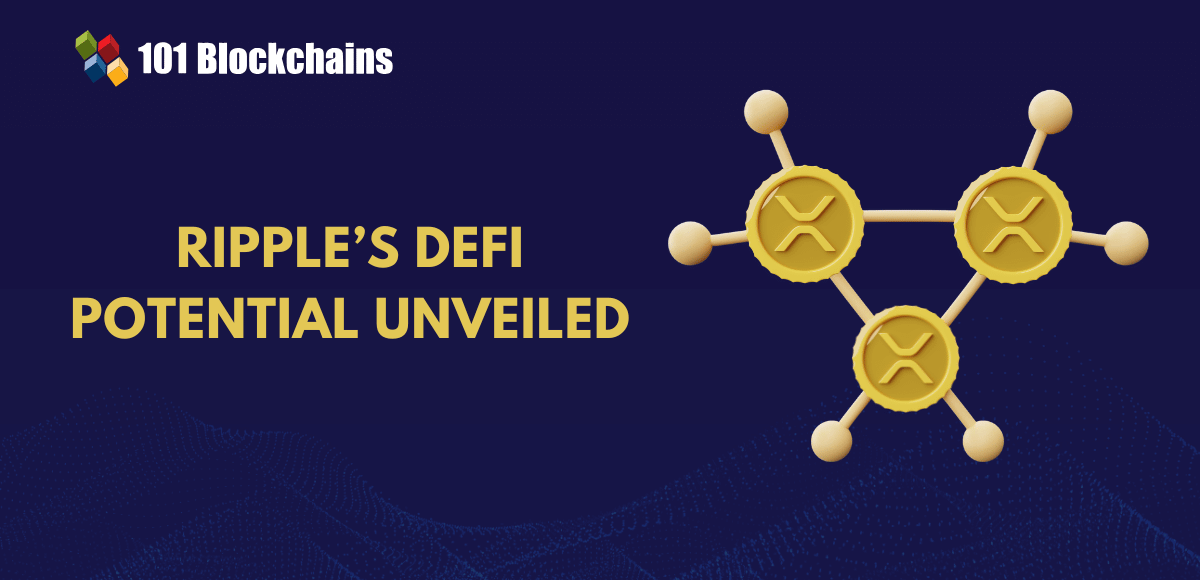Learn how blockchain truly works, master key definitions, and uncover what makes smart contracts so "smart." Dive into the fundamentals, gain valuable insights, and start your blockchain journey today!

- Decentralized Finance
James Howell
- on October 21, 2022
10 Best DeFi Security Best Practices
The development of DeFi protocols on a broad scale has been a prominent highlight for the blockchain and crypto space. However, security is still one of the important concerns for DeFi protocols, particularly before launching a protocol to users. The emphasis on top DeFi security best practices is essential as the protocols would deal with the finances of users.
You can guess how security can improve trust and the adoption of DeFi protocols. What are the potential reasons underlying the emphasis on DeFi security? The following discussion helps you find out the answer with an overview of DeFi security risks developers need to account for in 2022. Subsequently, you can discover the top best practices for DeFi security alongside the issues they resolve.
Want to explore an in-depth understanding of security threats in DeFi projects? Enroll in DeFi Security Fundamentals Course Now!
Reason to Focus on DeFi Security
Most of the teams in DeFi would focus specifically on the setbacks in their code to deal with DeFi security vulnerabilities, albeit with limited results. Developers must have in-depth knowledge regarding popular DeFi security risks such as brute force attacks, oracle attacks and other threats. The reason for emphasizing DeFi security becomes clearly evident in the critical nature of risks in the domain. Here is an outline of notable DeFi security risks developers must watch out for in 2022.
-
Exploiting Sources of Randomness
DeFi protocols use inputs related to blockchain production only, thereby enabling users and miners to take undue advantage. Some of the blockchain security examples would show re-rolling the outcomes of DeFi apps or reordering transactions.
-
Manipulated Oracles
Oracles are a vital source of information for the DeFi protocols. Time-weighted average price oracles could result in many profound issues for DeFi security as they draw information from one specific exchange. Therefore, TWAP oracles are not a credible indicator of price as the reported price could not showcase the larger market spot price.
-
Unprecedented Token Migrations
Token or liquidity migrations are evident in scenarios where a specific project transfers the tokens between liquidity providers. Token migrations are evident in scenarios where a project could upgrade to the new version of the native token. Such events can result in low liquidity for the existing pool, thereby making it more susceptible to market manipulation. Token migration could create an additional layer of risk as a new native token would need a new price feed for accurate reports on asset prices.
The possible risks underlying a DeFi security attack could be as innovative as the applications in DeFi. Therefore, it is important to practice caution by following the important best practices for ensuring the security of DeFi dApps.
Want to learn and understand the scope and purpose of DeFi? Enroll Now in Introduction to DeFi- Decentralized Finance Course
Best Practices for DeFi Security
The common risks for DeFi protocols proved that blockchain-based dApps could have different vulnerabilities. Most important of all, the complexity of DeFi security risks and the radically evolving web3 landscape offer new threats to DeFi. On the other hand, you can address the problems in DeFi security with the following best practices.

1. Reentrancy Attacks
The first addition among the best DeFi security best practices would refer to the safeguards against reentrancy attacks. It is a variant of the DAO hack involving a contract calling an external contract to update its state. Contracts are an integral part of DeFi, and they have some special functions, such as receive and fallback.
Manipulation of the contract could help in withdrawing funds without the sender’s attention. The best practice for such a situation is to update the internal state of the contract. Make sure that you update the internal state before calling an untrusted external contract or transferring ETH and tokens.
2. Source of Randomness
The source of randomness or anything you use with blocks for obtaining a random number could open up DeFi security vulnerabilities of an application. Randomness could be useful for many reasons in the case of smart contracts, especially for use cases involving distribution without any bias. On the other hand, blockchain systems are inherently deterministic and do not have a tamper-proof source for random numbers.
Therefore, it is difficult to find a random number without moving out of the blockchain. In such cases, developers need a solution that works as a verifiable randomness oracle. The method for creating randomness should be tamper-proof and verifiable, alongside offering the value of cryptographic security.
3. Rely on Testing and Static Analysis Tool
The next alternative in top DeFi security best practices points to testing and the use of static analysis tools. Tests on your application are a reliable option for dealing with DeFi security risks. An automated testing tool or platform could offer better command over testing.
Some of the top DeFi protocols, such as Synthetix and Aave, feature sample testing suites, which can help in understanding testing best practices. On top of it, static analysis tools can help in faster identification of bugs, designed for automatically running through the contract and securing potential vulnerabilities.
4. Transparency and Restrictions on Function
The different aspects of function transparency or visibility are evident in Solidity, the preferred language for developing DeFi protocols. Function visibility includes public, private, external, and internal, and it determines the extent of access for a specific group of users.
Visibility and restriction could offer proper access authorization to enable specific functions. Best practices for managing visibility and restriction can ensure better benefits for contract management. However, such best practices for resolving DeFi security risks can bring concerns about centralization in DeFi protocols.
Want to understand the best ways to use DeFi development tools like Solidity, React, and Hardhat? Enroll now in DeFi Development Course!
5. Safeguards against Frontrunning
Blockchain networks have all their transactions in the mempool, thereby ensuring the opportunity for viewing transactions. Users can also use the mempool to make a transaction before their transaction goes through to ensure profits from the transactions. The possible solutions to such a DeFi security attack would primarily be evident in the form of fair sequencing services.
The fair sequencing services could work as an off-chain service for ordering transactions on the basis of the temporal perspective on fairness outlined in the dApps. Fair sequencing services can offer a reliable answer for solving the issues of frontrunning alongside reducing fees for blockchain users.
6. Look Out for the Common Errors
The outline of best DeFi security best practices would involve an emphasis on common glitches in the code for smart contracts. Without the proper DeFi security principles, you are more likely to welcome more issues into the code. Some of the common issues which you must resolve in a DeFi protocol include overflows or underflows and loops gas limit. In addition, you must also avoid using “tx.origin” alongside focusing on proxy storage collection, proper data removal, and accuracy in the calculation of token transfer.
Start learning Decentralized Finance (DeFi) with World’s first DeFi Skill Path with quality resources tailored by industry experts Now!
7. Avoid AMM or DEX Reserves as Price Oracle
The most common practices for compromising DeFi protocols involve the use of AMM and DEX reserves as the price oracle. A centralized price oracle exploits evident with the user manipulating the spit price for an order book or AMM-based DEX. The favorable solution in such cases would refer to a decentralized oracle.
One of the best practices for addressing the DeFi security examples of exploits due to oracle attacks is to look for an alternative to centralized oracles. Decentralized oracles can help in finding out the true value of exchange rates, thereby ensuring better decisions for security.
8. Security is a Journey
One of the general assumptions about a DeFi security attack is that a specific and definitive solution can help in resolving the issue. However, DeFi security risks evolve along with the progress in the case of DeFi protocols. Therefore, you need to stay one step ahead in mastering DeFi security with updated monitoring and alerts for security risks and incidents. In addition, the efforts in DeFi security could also involve preparing the smart contract for the future by empowering it with dynamic sources of security intelligence.
9. Employ an External Audit before Deployment
The list of top DeFi security best practices would involve an external audit before deploying to the main network. It is more like a peer review for testing the security of the code. Auditors could approach the complete codebase by checking each line, thereby enabling better scope for identifying vulnerabilities.
Deploying the DeFi protocol without an audit is a recipe for welcoming security vulnerabilities in DeFi protocols. Therefore, the audit must be comprehensive and focus on detailed documentation, transparency in communication channels, and feedback in code for easier understanding. On the other hand, you must remember that security audits would not solve everything when it comes to DeFi security.
10. Build a Disaster Recovery Plan
The most crucial and pragmatic highlight for dealing with DeFi security vulnerabilities refers to a disaster recovery plan. Some of the common suggestions for a disaster recovery plan include upgrade plans or insurance. Another proven solution for disaster recovery plans includes the installation of the emergency ‘pause’ feature.
Insurance protocols have been working as decentralized methods for disaster recovery while adding financial security. On the other hand, an emergency ‘pause’ feature could hold off all the operations of the smart contract, thereby rendering the DeFi protocol inactive. However, each plan has its own share of setbacks and advantages. You can choose the one which suits your requirements the best.
Excited to learn about the critical vulnerabilities and security risks in smart contract development, Enroll now in the Smart Contracts Security Course!
Final Words
The different entries among best DeFi security best practices proved the prominence of many notable considerations in designing DeFi protocols. The financial burden of the attacks on DeFi protocols has also pointed out the need for emphasizing DeFi security. On the other hand, the constantly evolving nature of security vulnerabilities calls for attention to DeFi security best practices.
The DeFi community must work together and address the risks evident throughout the ecosystem. You should focus on the ground-level approach to DeFi security and work on building secure DeFi protocols. Learn more about decentralized finance and become an expert with credible learning resources.
*Disclaimer: The article should not be taken as, and is not intended to provide any investment advice. Claims made in this article do not constitute investment advice and should not be taken as such. 101 Blockchains shall not be responsible for any loss sustained by any person who relies on this article. Do your own research!





![30+ Best Decentralized Finance Applications [Updated] best decentralized finance (DeFi) applications](https://101blockchains.com/wp-content/uploads/2020/10/decentralized-finance-applications.png)

